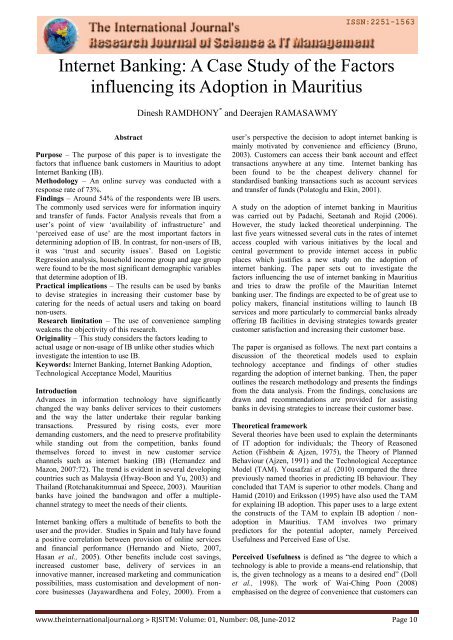Research Journal of Science & IT Management - RJSITM - The ...
Research Journal of Science & IT Management - RJSITM - The ...
Research Journal of Science & IT Management - RJSITM - The ...
Create successful ePaper yourself
Turn your PDF publications into a flip-book with our unique Google optimized e-Paper software.
Internet Banking: A Case Study <strong>of</strong> the Factors<br />
influencing its Adoption in Mauritius<br />
Dinesh RAMDHONY * and Deerajen RAMASAWMY<br />
Abstract<br />
Purpose – <strong>The</strong> purpose <strong>of</strong> this paper is to investigate the<br />
factors that influence bank customers in Mauritius to adopt<br />
Internet Banking (IB).<br />
Methodology – An online survey was conducted with a<br />
response rate <strong>of</strong> 73%.<br />
Findings – Around 54% <strong>of</strong> the respondents were IB users.<br />
<strong>The</strong> commonly used services were for information inquiry<br />
and transfer <strong>of</strong> funds. Factor Analysis reveals that from a<br />
user’s point <strong>of</strong> view ‘availability <strong>of</strong> infrastructure’ and<br />
‘perceived ease <strong>of</strong> use’ are the most important factors in<br />
determining adoption <strong>of</strong> IB. In contrast, for non-users <strong>of</strong> IB,<br />
it was ‘trust and security issues’. Based on Logistic<br />
Regression analysis, household income group and age group<br />
were found to be the most significant demographic variables<br />
that determine adoption <strong>of</strong> IB.<br />
Practical implications – <strong>The</strong> results can be used by banks<br />
to devise strategies in increasing their customer base by<br />
catering for the needs <strong>of</strong> actual users and taking on board<br />
non-users.<br />
<strong>Research</strong> limitation – <strong>The</strong> use <strong>of</strong> convenience sampling<br />
weakens the objectivity <strong>of</strong> this research.<br />
Originality – This study considers the factors leading to<br />
actual usage or non-usage <strong>of</strong> IB unlike other studies which<br />
investigate the intention to use IB.<br />
Keywords: Internet Banking, Internet Banking Adoption,<br />
Technological Acceptance Model, Mauritius<br />
Introduction<br />
Advances in information technology have significantly<br />
changed the way banks deliver services to their customers<br />
and the way the latter undertake their regular banking<br />
transactions. Pressured by rising costs, ever more<br />
demanding customers, and the need to preserve pr<strong>of</strong>itability<br />
while standing out from the competition, banks found<br />
themselves forced to invest in new customer service<br />
channels such as internet banking (IB) (Hernandez and<br />
Mazon, 2007:72). <strong>The</strong> trend is evident in several developing<br />
countries such as Malaysia (Hway-Boon and Yu, 2003) and<br />
Thailand (Rotchanakitumnuai and Speece, 2003). Mauritian<br />
banks have joined the bandwagon and <strong>of</strong>fer a multiplechannel<br />
strategy to meet the needs <strong>of</strong> their clients.<br />
Internet banking <strong>of</strong>fers a multitude <strong>of</strong> benefits to both the<br />
user and the provider. Studies in Spain and Italy have found<br />
a positive correlation between provision <strong>of</strong> online services<br />
and financial performance (Hernando and Nieto, 2007,<br />
Hasan et al., 2005). Other benefits include cost savings,<br />
increased customer base, delivery <strong>of</strong> services in an<br />
innovative manner, increased marketing and communication<br />
possibilities, mass customisation and development <strong>of</strong> noncore<br />
businesses (Jayawardhena and Foley, 2000). From a<br />
user’s perspective the decision to adopt internet banking is<br />
mainly motivated by convenience and efficiency (Bruno,<br />
2003). Customers can access their bank account and effect<br />
transactions anywhere at any time. Internet banking has<br />
been found to be the cheapest delivery channel for<br />
standardised banking transactions such as account services<br />
and transfer <strong>of</strong> funds (Polatoglu and Ekin, 2001).<br />
A study on the adoption <strong>of</strong> internet banking in Mauritius<br />
was carried out by Padachi, Seetanah and Rojid (2006).<br />
However, the study lacked theoretical underpinning. <strong>The</strong><br />
last five years witnessed several cuts in the rates <strong>of</strong> internet<br />
access coupled with various initiatives by the local and<br />
central government to provide internet access in public<br />
places which justifies a new study on the adoption <strong>of</strong><br />
internet banking. <strong>The</strong> paper sets out to investigate the<br />
factors influencing the use <strong>of</strong> internet banking in Mauritius<br />
and tries to draw the pr<strong>of</strong>ile <strong>of</strong> the Mauritian Internet<br />
banking user. <strong>The</strong> findings are expected to be <strong>of</strong> great use to<br />
policy makers, financial institutions willing to launch IB<br />
services and more particularly to commercial banks already<br />
<strong>of</strong>fering IB facilities in devising strategies towards greater<br />
customer satisfaction and increasing their customer base.<br />
<strong>The</strong> paper is organised as follows. <strong>The</strong> next part contains a<br />
discussion <strong>of</strong> the theoretical models used to explain<br />
technology acceptance and findings <strong>of</strong> other studies<br />
regarding the adoption <strong>of</strong> internet banking. <strong>The</strong>n, the paper<br />
outlines the research methodology and presents the findings<br />
from the data analysis. From the findings, conclusions are<br />
drawn and recommendations are provided for assisting<br />
banks in devising strategies to increase their customer base.<br />
<strong>The</strong>oretical framework<br />
Several theories have been used to explain the determinants<br />
<strong>of</strong> <strong>IT</strong> adoption for individuals; the <strong>The</strong>ory <strong>of</strong> Reasoned<br />
Action (Fishbein & Ajzen, 1975), the <strong>The</strong>ory <strong>of</strong> Planned<br />
Behaviour (Ajzen, 1991) and the Technological Acceptance<br />
Model (TAM). Yousafzai et al. (2010) compared the three<br />
previously named theories in predicting IB behaviour. <strong>The</strong>y<br />
concluded that TAM is superior to other models. Chang and<br />
Hamid (2010) and Eriksson (1995) have also used the TAM<br />
for explaining IB adoption. This paper uses to a large extent<br />
the constructs <strong>of</strong> the TAM to explain IB adoption / nonadoption<br />
in Mauritius. TAM involves two primary<br />
predictors for the potential adopter, namely Perceived<br />
Usefulness and Perceived Ease <strong>of</strong> Use.<br />
Perceived Usefulness is defined as “the degree to which a<br />
technology is able to provide a means-end relationship, that<br />
is, the given technology as a means to a desired end” (Doll<br />
et al., 1998). <strong>The</strong> work <strong>of</strong> Wai-Ching Poon (2008)<br />
emphasised on the degree <strong>of</strong> convenience that customers can<br />
www.theinternationaljournal.org > RJS<strong>IT</strong>M: Volume: 01, Number: 08, June-2012 Page 10
















